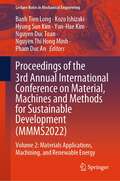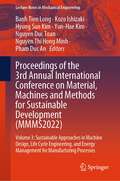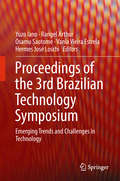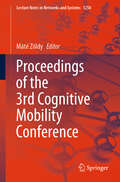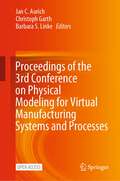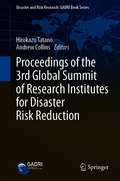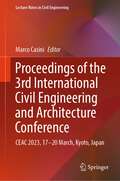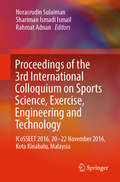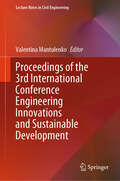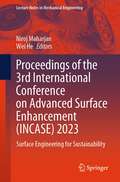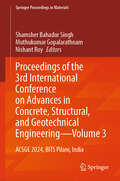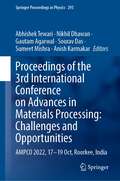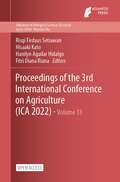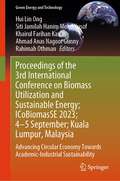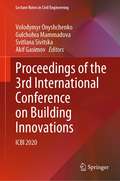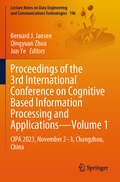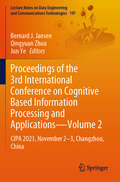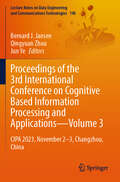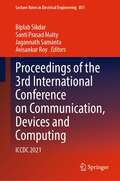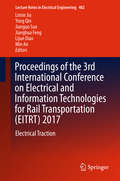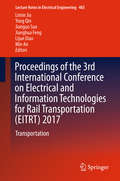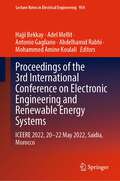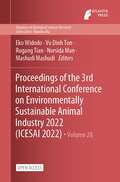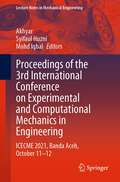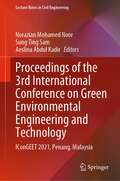- Table View
- List View
Proceedings of the 3rd Annual International Conference on Material, Machines and Methods for Sustainable Development: Volume 2: Materials Applications, Machining, and Renewable Energy (Lecture Notes in Mechanical Engineering)
by Yun-Hae Kim Banh Tien Long Kozo Ishizaki Nguyen Duc Toan Hyung Sun Kim Nguyen Thi Hong Minh Pham Duc AnThis book presents selected, peer-reviewed proceedings of the 3rd International Conference on Material, Machines and Methods for Sustainable Development (MMMS2022), held in the city of Can Tho, Vietnam, from 10 to 13 November 2022. The purpose of the conference is to explore and ensure an understanding of the critical aspects contributing to sustainable development with a focus on advanced mechanical engineering, automation, materials, machines and methods. The contributions published in this book come from authors representing universities, research institutes and industrial companies and reflect the results of a very broad spectrum of research, from micro- and nanoscale materials design and processing, to mechanical engineering technology in industry. Many of the contributions selected for these proceedings focus on materials modeling, eco-material processes and mechanical manufacturing. Volume 2 of this book focuses on topics dedicated to materials applications, machining, and renewable energy. Selected topics include: material machinability and economic efficiency, sustainable development manufacturing technology, environmental protection, as well as green development and climate change prevention.
Proceedings of the 3rd Annual International Conference on Material, Machines and Methods for Sustainable Development: Volume 3: Sustainable Approaches in Machine Design, Life Cycle Engineering, and Energy Management for Manufacturing Processes (Lecture Notes in Mechanical Engineering)
by Yun-Hae Kim Banh Tien Long Kozo Ishizaki Nguyen Duc Toan Hyung Sun Kim Nguyen Thi Hong Minh Pham Duc AnThis book presents selected, peer-reviewed proceedings of the 3rd International Conference on Material, Machines and Methods for Sustainable Development (MMMS2022), held in the city of Can Tho, Vietnam, from 10 to 13 November 2022. The purpose of the conference is to explore and ensure an understanding of the critical aspects contributing to sustainable development with a focus on advanced mechanical engineering, automation, materials, machines and methods. The contributions published in this book come from authors representing universities, research institutes and industrial companies and reflect the results of a very broad spectrum of research, from micro- and nanoscale materials design and processing, to mechanical engineering technology in industry. Many of the contributions selected for these proceedings focus on materials modeling, eco-material processes and mechanical manufacturing. Volume 3 of this book focuses on topics dedicated to sustainable approaches in machine design, life cycle engineering, and energy management for manufacturing processes.
Proceedings of the 3rd Brazilian Technology Symposium: Emerging Trends And Challenges In Technology
by Yuzo Iano Rangel Arthur Osamu Saotome Vania Vieira Estrela Hermes José LoschiThis book presents the proceedings of the 3rd Brazilian Technology Symposium (BTSym), which is a multi/trans/interdisciplinary event offering an excellent forum for presentations and discussions of the latest scientific and technological developments in various areas of research, with an emphasis on smart design and future technologies. It brings together researchers, students and professionals from the industrial and academic sectors to discuss current technological issues. Among the main topics covered in this book, we can highlight Artificial Neural Networks, Computational Vision, Security Applications, Web Tool, Cloud Environment, Network Functions Virtualization, Software-Defined Networks, IoT, Residential Automation, Data Acquisition, Industry 4.0, Cyber-Physical Systems, Digital Image Processing, Infrared Images, Patters Recognition, Digital Video Processing, Precoding, Embedded Systems, Machine Learning, Remote Sensing, Wireless Sensor Network, Heterogeneous Networks, Unmanned Ground Vehicle, Unmanned Aerial System, Security, Surveillance, Traffic Analysis, Digital Television, 5G, Image Filter, Partial Differential Equation, Smoothing Filters, Voltage Controlled Ring Oscillator, Difference Amplifier, Photocatalysis, Photodegradation, Cosmic Radiation Effects, Radiation Hardening Techniques, Surface Electromyography, Sickle cell disease methodology, MicroRNAs, Image Processing Venipuncture, Cognitive Ergonomics, Ecosystem services, Environmental, Power Generation, Ecosystem services valuation, Solid Waste and University Extension.
Proceedings of the 3rd Cognitive Mobility Conference (Lecture Notes in Networks and Systems #1258)
by Máté ZöldyThis book introduces innovative methods and new insights, offering a comprehensive exploration of cognitive mobility's diverse dimensions. It discovers a pioneering perspective on cognitive mobility that redefines our understanding of this dynamic field. Integrating cutting-edge research and practical applications, it is an invaluable resource for academics and practitioners. Covering topics from theoretical foundations to real-world implementations, it provides a holistic understanding of cognitive mobility. Designed for researchers, educators, and practitioners, this book is an essential reference for deepening understanding and application of cognitive mobility concepts. Whether developing new technologies, educational programs, or conducting cognitive science research, this book offers the tools and insights needed to advance your work. Focusing on the latest developments and practical applications, it enriches understanding and empowers innovation in the field of cognitive mobility.
Proceedings of the 3rd Conference on Physical Modeling for Virtual Manufacturing Systems and Processes
by Jan C. Aurich Christoph Garth Barbara S. LinkeThis is an open access book reporting the results of nine years research of the International Research Training Group (IRTG) 2057, funded by the German Research Foundation (DFG). The IRTG is a joint venture between the TU Kaiserslautern, the University of California Berkeley, and University of California Davis.The book is content-driven mainly by two disciplines: engineering and computer science. Through the application of scientific knowledge and advanced computer-based methods in conjunction with physical models on a level unrealized in the past, technologies and methods are promoted, which can be used for planning and optimization of manufacturing systems and processes. As a result, fundamental understanding as well as extensive systems, tools and computational algorithms, which significantly improve the integration of advanced computational methods for solving problems of manufacturing systems and processes will be available.This open access book is of interest to any researcher dealing with process and factory planning in manufacturing, like for cutting and additive manufacturing.
Proceedings of the 3rd Global Summit of Research Institutes for Disaster Risk Reduction (Disaster and Risk Research: GADRI Book Series)
by Andrew Collins Hirokazu TatanoThis book presents selected papers from the 3rd Global Summit of Research Institutes for Disaster Risk Reduction – Expanding the Platform for Bridging Science and Policy Making, which was held at the Disaster Prevention Research Institute (DPRI), Kyoto University, Uji Campus from 19 to 21 March 2017. It was organised by the Global Alliance of Disaster Research Institutes (GADRI), which was established soon after the second Global Summit and the UN World Conference on Disaster Risk Reduction in March 2015, and is intended to support the implementation of the Sendai Framework for Disaster Risk Reduction 2015–2030.The conference not only provided a platform for discussion and exchange of information on key current and future research projects on disaster risk reduction and management, but also promoted active dialogues through group discussion sessions that addressed various disaster research disciplines.In this book, authors from various disciplines working at governmental and international organisations provide guidance to the science and technical community, discuss the current challenges, and evaluate the research needs and gaps in the context of climate change, sustainable development goals and other interlinked global disaster situations. Expert opinions from practitioners and researchers provide valuable insights into how to connect and engage in collaborative research with the international science and technical communities and other stakeholders to achieve the goals set out in the agenda of the Sendai Framework for Disaster Risk Reduction 2015–2030. In addition, case studies and other evidence-based research papers highlight ongoing research projects and reflect the challenges encountered in information sharing by various stakeholders in the context of disaster risk reduction and management.Chapter “Science and technology commitment to the implementation of the Sendai Framework for Disaster Risk Reduction 2015-2030” is available open access under a Creative Commons Attribution 4.0 International License via link.springer.com.
Proceedings of the 3rd International Civil Engineering and Architecture Conference: CEAC 2023, 17-20 March, Kyoto, Japan (Lecture Notes in Civil Engineering #389)
by Marco CasiniThis book collects the scientific proceedings presented during the "2023 The 3rd International Civil Engineering and Architecture Conference” held in Kyoto in March 2023 with the aim of showing the latest advancements in theoretical and applied research in the architecture, engineering, and construction (AEC) sector. Worldwide, the growing demand is for green and smart buildings that are perfectly integrated into the surrounding environment, have efficient energy and resource consumption, use environmentally friendly materials and renewable energies, favor recycling and reuse, and offer improved indoor comfort and air quality. The book provides readers with an overview of the ongoing transformation of the AEC industry presenting a thorough investigation of the emerging trends and challenges in the fields of green building design, construction and operation. Its content caters to researchers, engineers and architects working in the field of theoretical, experimental and practical civil engineering and architecture.
Proceedings of the 3rd International Colloquium on Sports Science, Exercise, Engineering and Technology: ICoSSEET 2016, 20-22 November 2016, Kota Kinabalu, Malaysia
by Shariman Ismadi Ismail Norasrudin Sulaiman Rahmat AdnanThis proceedings volume explores a range of sports-related topics, including sports science, exercise, sports engineering and technology, in contributions prepared by respected experts and presented at the 3rd International Colloquium on Sports Science, Exercise, Engineering and Technology (ICoSSEET2016). The goal of the conference was to bring together researchers and practitioners from academia and industry to address current challenges in various sports-related areas, and to establish vital new collaborations. The topics covered can be primarily divided into (1) Sports Science and Exercise, (2) Sports Engineering and Technology Application, and (3) Sports Industry and Management.
Proceedings of the 3rd International Conference Engineering Innovations and Sustainable Development (Lecture Notes in Civil Engineering #540)
by Valentina MantulenkoThis book presents the contributions from the 3rd International Conference Engineering Innovations and Sustainable Development, held in Samara, Russia on April 26, 2024. By presenting international research on various sustainability issues, it includes topics such as current trends in industrial and agricultural development, innovations in the construction and transport sectors, problems concerning the financing of innovative activities and governmental support for innovations, and engineering competences and skills in the era of new technologies. It also covers the economic, environmental, and informational aspects of sustainable development in the context of innovations. Finally, the book addresses theoretical and practical aspects by studying the phenomenon of sustainability and engineering development in terms of comparing international experiences. It provides significant value for scientists, teachers, and students of higher educational institutions, and specialists, who are researching sustainable development issues in the era of engineering innovations.
Proceedings of the 3rd International Conference on Advanced Surface Enhancement: Surface Engineering for Sustainability (Lecture Notes in Mechanical Engineering)
by Wei He Niroj MaharjanThis book presents the proceedings of the ‘3rd International Conference on Advanced Surface Enhancement’, INCASE 2023. It compiles the papers presented by researchers in surface engineering field at INCASE 2023 conference. The book presents a comprehensive review of the state of the art in surface engineering-related techniques and strategies, with a focus towards sustainability. The main topics include ‘Advanced techniques for surface engineering towards enhanced performance’, ‘Surface and sub-surface characterisation’, ‘Simulation and modelling of surface integrity’, ‘Advanced coating materials design synthesis and industry applications’, and ‘Emerging trends in surface engineering’. The book identifies the gaps between research and manufacturing and promotes sustainable approaches towards development of surface engineering solutions for adoption by industry. The book is useful for researchers, scientists, students, and engineers working in the field of surface engineering.
Proceedings of the 3rd International Conference on Advances in Concrete, Structural, and Geotechnical Engineering—Volume 3: ACSGE 2024, BITS Pilani, India (Springer Proceedings in Materials #31)
by Shamsher Bahadur Singh Muthukumar Gopalarathnam Nishant RoyThis book consists of selected papers presented at the 3rd International Conference on Advances in Concrete, Structural, and Geotechnical Engineering (ACSGE 2024) held at BITS, Pilani, India. The papers represent the latest research work in the fields of advanced composite materials, advanced computational techniques for structures, applications of nanotechnology in civil engineering, bridge engineering, composite structures, concrete technology, the fatigue life of structures, fire-resistant structures, functionally graded materials and structures, geotechnical processes, ground improvement techniques, offshore structures, performance-based design of structures, pre-cast pre-stressed concrete structures, seismic design, and construction, soil structure interaction, structural health assessment and rehabilitation, sustainability of construction, design, and management. The papers are presented by an international pool of academics, research scientists, and industrial experts and therefore cater to the global audience from the fields of construction materials, design guidelines, geotechnical engineering, concrete infrastructures, and structural engineering. This book is part of a 3-volume series of these conference proceedings, and it represents Volume 3 in the series.
Proceedings of the 3rd International Conference on Advances in Materials Processing: AMPCO 2022, 17-19 Oct, Roorkee, India (Springer Proceedings in Physics #293)
by Sourav Das Nikhil Dhawan Abhishek Tewari Gautam Agarwal Sumeet Mishra Anish KarmakarThis book presents peer reviewed articles from the 3rd International Conference on Advances in Materials Processing: Challenges and Opportunities (AMPCO 2022), held at IIT Roorkee, India. It highlights recent progress made in the fields of materials processing, advanced steel technology and materials for sustainability. The conference is also special as it is being organized on the occasion of 60 years of the department of metallurgical and materials engineering as well as 175 years of IIT Roorkee.
Proceedings of the 3rd International Conference on Agriculture (Advances in Biological Sciences Research #33)
by Risqi Firdaus Setiawan Hisaaki Kato Hanilyn Aguilar Hidalgo Fitri Diana RianaThis is an open access book.The global economy is by definition the movement of resources (goods, services and capital) across national borders. The more open relations between countries will affect changes in the regional and global regions, this condition is characterized by the level of domestic economic resilience. Currently, technology with its dynamics requires every country to move to follow, citing at the G20 the role of multilateral trading system to strengthen the achievement SDGs, digital trade sustainable, global value chains (GVCs) and sustainable and inclusive industrialization via industry 4.0.Based on the statement above, it shows that modernization and sustainable 4.0 equivalent industrialization are the demands of multi-sectors including the agricultural sector. For Indonesia, agriculture plays a strategic role in the national economy, with the challenges of sustainable agriculture, the role of agriculture is shown in addition to being a provider of food, industrial raw materials, feed and bioenergy, a source of labor absorption, a source of state foreign exchange as well as environmental preservation with an environmentally friendly farming program approach. Sustainable agriculture practices are ideal, but the dimensions of the scope of sustainable agriculture interests and the substance of their meaning are definitely different.Through the international agricultural seminar or The 3rd International Conference Agriculture (ICA) with the theme Modernization And Industrialization To Support Sustainable Agriculture Facing Global Economy which will be held on September 21, 2022 is one of the efforts in equalizing understanding and collecting sustainable farming innovations that are in line with the sustainable development goals and have become the country's commitment in order to implement the Sustainable Development Goals (SDGs) in the face of the global economy.
Proceedings of the 3rd International Conference on Biomass Utilization and Sustainable Energy; ICoBiomasSE 2023; 4–5 September; Kuala Lumpur, Malaysia: Advancing Circular Economy Towards Academic-Industrial Sustainability (Green Energy and Technology)
by Hui Lin Ong Siti Jamilah Hanim Mohd Yusof Khairul Farihan Kasim Ahmad Anas Nagoor Gunny Rahimah OthmanThis book presents peer-reviewed articles from the 3rd International Conference on Biomass Utilization and Sustainable Energy 2023 (ICoBiomasSE 2023), Malaysia. The theme of the conference "Advancing Circular Economy Towards Academic-Industrial Sustainability" has been chosen in consideration of the emergence of circular economy concepts in the field of biomass innovation towards sustainable development. The contents are broadly divided into five parts: (1) sustainable biomass resources for decarbonising the economy, (2) biomass conversion technologies for bioenergy and biofuels, (3) biomass conversion to intermediates and products, (4) bioeconomy sustainability, impacts, and policies, and (5) bioenergy integration. It provides a platform to college or graduate students, professionals, researchers, academicians, policy makers, and industries working in the areas of biomass utilization and sustainable energy to solve long-standing environmental issues for healthier planet. It may also be of interests for environmentalist and materialists who work on planning, engineering, and management fields.
Proceedings of the 3rd International Conference on Building Innovations: ICBI 2020 (Lecture Notes in Civil Engineering #181)
by Volodymyr Onyshchenko Gulchohra Mammadova Svitlana Sivitska Akif GasimovThis book gathers the latest advances, innovations, and applications in the field of building design and construction, by focusing on new design solutions for buildings and new technologies creation for construction, as presented by researchers and engineers at the 3rd International Conference Building Innovations (ICBI), held in Poltava – Baku, Ukraine – Azerbaijan, on June 1-2, 2020. It covers highly diverse topics, including structures operation, repairing and thermal modernization in existing buildings and urban planning features, machines and mechanisms for construction, as well as efficient economy and energy conservation issues in construction. The contributions, which were selected by means of a rigorous international peer-review process, highlight numerous exciting ideas that will spur novel research directions and foster multidisciplinary collaborations.
Proceedings of the 3rd International Conference on Cognitive Based Information Processing and Applications–Volume 1: CIPA 2023, November 2–3, Changzhou, China (Lecture Notes on Data Engineering and Communications Technologies #196)
by Jun Ye Bernard J. Jansen Qingyuan ZhouThis book contains papers presented at the 3rd International Conference on Cognitive- based Information Processing and Applications (CIPA) in Changzhou, China, from November 2–3, 2023. The papers represent the various technological advancements in theory, technology and application of artificial intelligence, including precision mining, intelligent computing, deep learning, and all other theories, models, and technologies related to artificial intelligence. It caters to postgraduate students, researchers, and practitioners specializing and working in the area of cognitive-inspired computing and intelligent computing. The book represents Volume 1 for this conference proceedings, which consists of a 3-volume book series.
Proceedings of the 3rd International Conference on Cognitive Based Information Processing and Applications—Volume 2: CIPA 2023, November 2—3, Changzhou, China (Lecture Notes on Data Engineering and Communications Technologies #197)
by Jun Ye Bernard J. Jansen Qingyuan ZhouThis book contains papers presented at the 3rd International Conference on Cognitive- based Information Processing and Applications (CIPA) in Changzhou, China, from November 2–-3, 2023. The papers represent the various technological advancements in theory, technology and application of artificial intelligence, including precision mining, intelligent computing, deep learning, and all other theories, models, and technologies related to artificial intelligence. It caters to postgraduate students, researchers, and practitioners specializing and working in the area of cognitive-inspired computing and intelligent computing. The book represents Volume 2 for this conference proceedings, which consists of a 3-volume book series.
Proceedings of the 3rd International Conference on Cognitive Based Information Processing and Applications—Volume 3: CIPA 2023, November 2–3, Changzhou, China (Lecture Notes on Data Engineering and Communications Technologies #198)
by Jun Ye Bernard J. Jansen Qingyuan ZhouThis book contains papers presented at the 3rd International Conference on Cognitive- based Information Processing and Applications (CIPA) in Changzhou, China, from November 2–3, 2023. The papers represent the various technological advancements in theory, technology and application of artificial intelligence, including precision mining, intelligent computing, deep learning, and all other theories, models, and technologies related to artificial intelligence. It caters to postgraduate students, researchers, and practitioners specializing and working in the area of cognitive-inspired computing and intelligent computing. The book represents Volume 3 for this conference proceedings, which consists of a 3-volume book series.
Proceedings of the 3rd International Conference on Communication, Devices and Computing: ICCDC 2021 (Lecture Notes in Electrical Engineering #851)
by Biplab Sikdar Santi Prasad Maity Jagannath Samanta Avisankar RoyThis book provides insights into the 3rd International Conference on Communication, Devices and Computing (ICCDC 2021), which was held in Haldia, India, on August 16–18, 2021. It covers new ideas, applications, and the experiences of research engineers, scientists, industrialists, scholars, and students from around the globe. The proceedings highlight cutting-edge research on communication, electronic devices, and computing and address diverse areas such as 5G communication, spread spectrum systems, wireless sensor networks, and signal processing for secure communication, error control coding, printed antennas, analysis of wireless networks, antenna array systems, analog and digital signal processing for communication systems, frequency selective surfaces, radar communication, and substrate integrated waveguide and microwave passive components, which are key to state-of-the-art innovations in communication technologies.
Proceedings of the 3rd International Conference on Electrical and Information Technologies for Rail Transportation: Electrical Traction (Lecture Notes In Electrical Engineering #482)
by Limin Jia Yong Qin Lijun Diao Jianghua Feng Min An Jianguo SuoThe proceedings collect the latest research trends, methods and experimental results in the field of electrical and information technologies for rail transportation. The topics cover novel traction drive technologies of rail transportation, safety technology of rail transportation system, rail transportation information technology, rail transportation operational management technology, rail transportation cutting-edge theory and technology etc. The proceedings can be a valuable reference work for researchers and graduate students working in rail transportation, electrical engineering and information technologies.
Proceedings of the 3rd International Conference on Electrical and Information Technologies for Rail Transportation: Electrical Traction (Lecture Notes In Electrical Engineering #482)
by Limin Jia Yong Qin Lijun Diao Jianghua Feng Min An Jianguo SuoThe proceedings collect the latest research trends, methods and experimental results in the field of electrical and information technologies for rail transportation. The topics cover novel traction drive technologies of rail transportation, safety technology of rail transportation system, rail transportation information technology, rail transportation operational management technology, rail transportation cutting-edge theory and technology etc. The proceedings can be a valuable reference work for researchers and graduate students working in rail transportation, electrical engineering and information technologies.
Proceedings of the 3rd International Conference on Electronic Engineering and Renewable Energy Systems: ICEERE 2022, 20 -22 May 2022, Saidia, Morocco (Lecture Notes in Electrical Engineering #954)
by Abdelhamid Rabhi Adel Mellit Hajji Bekkay Antonio Gagliano Mohammed Amine KoulaliThis book includes papers presented at the 3rd International Conference on Electronic Engineering and Renewable Energy (ICEERE 2022), which focus on the application of artificial intelligence techniques, emerging technology and the Internet of things in electrical and renewable energy systems, including hybrid systems, micro-grids, networking, smart health applications, smart grid, mechatronics and electric vehicles. It particularly focuses on new renewable energy technologies for agricultural and rural areas to promote the development of the Euro-Mediterranean region. Given its scope, the book is of interest to graduate students, researchers and practicing engineers working in the fields of electronic engineering and renewable energy.
Proceedings of the 3rd International Conference on Environmentally Sustainable Animal Industry 2022 (Advances in Biological Sciences Research #28)
by Eko Widodo Vu Dinh Ton Rugang Tian Norsida Man Mashudi MashudiThis is an open access book.The 3rd ICESAI aims to discuss issues related to the development of an eco-friendly and sustainable livestock industry using smart farming which is related to scientific research and how it is applied. The 3rd ICESAI offers opportunities for the for researchers and the livestock industry from all over the world to share experiences, learn and expand networking on several matters relating to the development of a sustainable and environmentally friendly livestock industry, especially with the implementation of smart farming.
Proceedings of the 3rd International Conference on Experimental and Computational Mechanics in Engineering: ICECME 2021, Banda Aceh, October 11-12 (Lecture Notes in Mechanical Engineering)
by Akhyar Syifaul Huzni Mohd IqbalThis book gathers a selection of peer-reviewed papers presented at the 3rd International Conference on Experimental and Computational Mechanics in Engineering (ICECME 2021), held as a virtual conference and organized by Universitas Syiah Kuala, Banda Aceh, Indonesia, on October 11–12, 2021.This book, prepared by international scientists and engineers, covers the latest advances in computational mechanics, metallurgy and material science, energy systems, manufacturing processing systems, industrial and system engineering, biomechanics, artificial intelligence, micro-/nano-engineering, micro-electro-mechanical system, machine learning, mechatronics, and engineering design. This book is intended for academics, including graduate students and researchers, as well as industrial practitioners working in the areas of experimental and computational mechanics.
Proceedings of the 3rd International Conference on Green Environmental Engineering and Technology: IConGEET 2021, Penang, Malaysia (Lecture Notes in Civil Engineering #214)
by Aeslina Abdul Kadir Norazian Mohamed Noor Sung Ting SamThis book presents high-quality peer-reviewed papers from the 3rd International Conference on Green Environmental Engineering and Technology (IConGEET), held in July 2021, Penang, Malaysia. The contents are broadly divided into four parts: (1) air pollution and climate change, (2) environment and energy management, (3) environmental sustainability, and (4) water and wastewater. The major focus is to present current researches in the field of environmental engineering towards green and sustainable technologies. It includes papers based on original theoretical, practical, and experimental simulations, development, applications, measurements, and testing. Featuring the latest advances in the field, this book serves as a definitive reference resource for researchers, professors, and practitioners interested in exploring advanced techniques in the field of environmental engineering and technologies.
